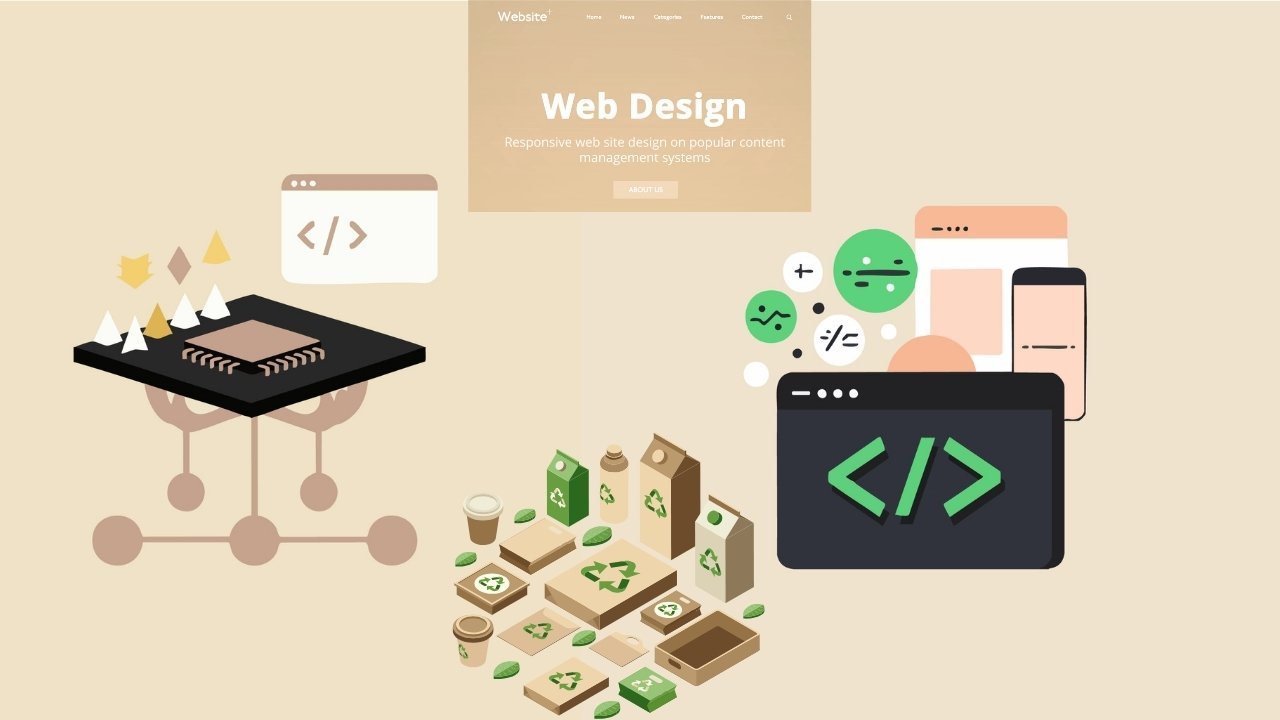Discover how to build eco-friendly, energy-efficient WordPress websites using lightweight themes, green hosting, and sustainable design principles. Learn best practices, tools, and plugins to reduce your digital carbon footprint in 2025.
Green Web Design in WordPress: Lightweight Themes, Eco-Friendly Plugins, and Sustainable Sites
Introduction
As the internet expands, so does its environmental footprint. Every website visit consumes electricity through servers, devices, and data transfer — contributing to carbon emissions. According to recent research, the global internet accounts for nearly 3.7% of all greenhouse gas emissions, similar to the aviation industry.
In this context, Green Web Design has emerged as a new standard for sustainable digital development. For WordPress developers, this means designing lightweight, optimized, and efficient websites that minimize resource usage — without compromising performance or user experience.
This article explores how to build eco-friendly WordPress sites using lightweight themes, sustainable hosting, and energy-efficient plugins — and why it matters for both the planet and your brand.
1. The Rise of Green Web Design
“Green Web Design” is not just a trend — it’s a responsibility. It involves developing websites that are optimized for energy efficiency, use fewer server resources, and deliver content with minimal data transfer.
The Three Core Principles of Green Web Design
-
Efficiency Use fewer resources for the same result.
-
Sustainability Choose hosting powered by renewable energy.
-
Longevity Build sites that are easy to maintain and update, reducing waste.
WordPress — as the world’s most popular CMS — is well-positioned to lead the sustainability shift through better coding practices, performance optimization, and thoughtful design choices.
2. Why WordPress Developers Should Care About Sustainability
Every image, line of code, and plugin adds digital “weight” to a website. The heavier the site, the more energy it consumes when loading and rendering.
🔹 Benefits of Green Web Design in WordPress
-
Lower carbon footprint Lighter sites consume less power and bandwidth.
-
Faster loading speed Optimized themes perform better for SEO and UX.
-
Improved SEO ranking Google rewards performance and Core Web Vitals.
-
Better user experience Reduced bloat means smoother browsing.
-
Brand trust Eco-conscious audiences favor sustainable brands.
For agencies, adopting green practices isn’t just ethical — it’s also a market advantage.
3. Lightweight WordPress Themes for Sustainable Design
A theme’s structure determines how much code runs on the front end. Choosing a lightweight, modular, and optimized theme significantly reduces server load and data transfer.
Recommended Lightweight WordPress Themes
-
GeneratePress Under 30 KB in size — fast, modular, and fully customizable.
-
Astra Optimized for performance and uses vanilla JavaScript (no jQuery).
-
Neve Mobile-first and minimal — ideal for eco-conscious developers.
-
Kadence Lightweight, SEO-ready, and works with block-based designs.
-
Blocksy Gutenberg-optimized with dynamic asset loading.
-
Kaddora Organic Block Theme (by Kaddora Tech) Tailored for organic brands — integrates clean code, block patterns, and WooCommerce-ready eco layouts.
Design Practices for Lightweight Themes
- Avoid heavy animations or video backgrounds.
- Use vector graphics (SVG) instead of large image files.
- Enable lazy loading for images and media.
- Minify CSS, HTML, and JavaScript.
- Use system fonts to reduce extra font requests.
The goal is to reduce HTTP requests and optimize every byte of your design.
4. Eco-Friendly WordPress Plugins: Efficiency Without Bloat
Plugins extend WordPress functionality, but excessive or poorly coded plugins can drain performance and energy.
Criteria for Choosing Eco-Friendly Plugins
- Minimal database queries
- Lightweight and modular
- Actively maintained and updated
- No unnecessary background processes
- Compatible with caching systems
Recommended Plugins for Sustainable Sites
Function | Eco-Friendly Plugin | Why It’s Green |
Caching | WP Super Cache / LiteSpeed Cache | Reduces server processing load |
Image Optimization | Smush / ShortPixel | Compresses images efficiently |
SEO | Rank Math | Lightweight alternative to bulkier SEO suites |
Performance Monitoring | Query Monitor | Helps diagnose and remove heavy scripts |
Lazy Loading | a3 Lazy Load | Loads media only when needed |
CDN Integration | Cloudflare Plugin | Delivers content efficiently from nearby servers |
Database Cleaning | WP-Optimize | Removes junk data and reduces DB size |
Always audit your plugins periodically — fewer is better.
5. Green Hosting: The Foundation of Sustainable WordPress
No matter how efficient your code is, hosting plays a major role in sustainability. Traditional data centers run on fossil fuels, but green hosting providers use renewable energy or carbon offsets.
Top Green Hosting Providers
-
GreenGeeks 300% renewable energy match, eco-certified.
-
A2 Hosting Uses carbon-neutral operations.
-
DreamHost Powered by renewable energy grids.
-
SiteGround Efficient server architecture with low power use.
-
WP Engine Committed to net-zero data centers by 2030.
Tips for Choosing a Sustainable Host
- Check for renewable energy certifications.
- Prefer data centers located near your audience to reduce latency.
- Choose scalable cloud hosting over shared, resource-heavy servers.
- Use CDNs (Content Delivery Networks) for geographic efficiency.
Switching to green hosting can instantly reduce your site’s carbon emissions by up to 70%.
6. Optimizing WordPress for Energy Efficiency
Once your theme and hosting are optimized, it’s time to fine-tune your website’s performance.
Technical Steps
-
Enable Caching Reduces repetitive server requests.
-
Compress Images Use WebP or AVIF for smaller file sizes.
-
Optimize Database Regularly clean revisions, spam, and transients.
-
Use a CDN Minimize global data transfer.
-
Remove Unused Plugins & Scripts Every line of code matters.
-
Implement GZIP or Brotli Compression Reduces overall page weight.
-
Enable HTTP/3 Faster, more efficient data transfer protocol.
Design & UX Practices
- Prefer static content over heavy dynamic scripts.
- Limit pop-ups and third-party embeds.
- Implement dark-mode options — OLED screens use less energy.
- Avoid auto-playing videos.
Sustainability is both a technical and design choice.
7. Sustainable Content Strategy: Less Is More
Sustainability extends beyond the code — it’s also about how much content you deliver.
Smart Content Practices
- Keep pages concise and relevant.
- Use compressed, optimized media.
- Archive outdated posts instead of serving them live.
- Implement “read-more” pagination to reduce initial load.
- Use static or cached pages for evergreen content.
Sustainable sites are not only greener — they’re faster and more user-friendly.
8. Measuring the Carbon Footprint of Your WordPress Site
Several tools can help you calculate your website’s environmental impact.
Recommended Tools
-
Website Carbon Calculator https://www.websitecarbon.com
-
Ecograder https://ecograder.com
-
Beacon measures energy efficiency and accessibility.
-
PageSpeed Insights indirectly supports sustainability by measuring performance.
These tools analyze your code, images, and hosting to estimate how many grams of CO₂ your site emits per page view.
Tip
A good target is under 0.5 g CO₂ per page view — achievable with optimized WordPress sites.
9. Case Study: Building a Sustainable WordPress Theme
Imagine developing a green-optimized WordPress theme like Kaddora Organic Block Theme — focused on eco brands, farms, or grocery stores.
Core Features
- Lightweight block-based design
- Minimalist CSS and JavaScript
- Eco color palette and accessibility compliance
- WooCommerce-ready for eco-shops
- AI-driven performance optimization
- Uses renewable-powered CDN integration
Result
Such a theme not only supports environmental branding but also reduces energy consumption — proving that design aesthetics and sustainability can coexist.
10. Future of Green WordPress Design
The future of web design will be green, inclusive, and intelligent. WordPress is evolving with tools like Full Site Editing (FSE), block patterns, and AI-assisted optimization, enabling developers to build cleaner, faster, and greener websites.
Trends to Watch
-
AI-Optimized Hosting Automatically scales energy-efficient resources.
-
Decentralized CDN networks Reduced data distance and redundancy.
-
Green-verified badges for sites To signal eco responsibility.
-
Sustainable WordPress Marketplaces Prioritizing lightweight themes.
Sustainability will soon become a ranking factor and a selling point — not just a technical consideration.
Top 10 Frequently Asked Questions (FAQs)
-
What is green web design in WordPress? It’s the practice of creating websites that use fewer resources, load faster, and minimize their carbon footprint through optimization and eco-friendly hosting.
-
How does a lightweight theme help the environment? Lightweight themes use minimal code, reducing data transfer and server processing — directly lowering energy usage.
-
Are there eco-friendly WordPress themes available? Yes — themes like Astra, GeneratePress, Neve, Blocksy, and Kaddora Organic Block Theme are optimized for speed and sustainability.
-
Which hosting providers are considered green? GreenGeeks, A2 Hosting, and DreamHost are top choices with renewable-energy-powered data centers.
-
Can plugins impact my website’s carbon footprint? Absolutely. Heavy or poorly coded plugins consume more server resources. Use minimal, optimized plugins only.
-
What’s the best way to measure my site’s sustainability? Tools like WebsiteCarbon.com and Ecograder analyze your website’s energy consumption and CO₂ output.
-
Does sustainable design affect SEO? Yes. Lightweight, fast-loading sites perform better on search engines and enhance Core Web Vitals scores.
-
Can I make an existing WordPress site more eco-friendly? Definitely. Optimize your images, switch to green hosting, remove bloat, and use caching plugins.
-
Are there eco plugins for WordPress? Not specific “green” plugins, but optimization tools like WP Super Cache, Smush, and WP-Optimize support sustainability by improving efficiency.
-
Why should my brand care about digital sustainability? It reflects environmental responsibility, improves performance, enhances brand image, and appeals to eco-conscious audiences.
Conclusion
Building a green WordPress website is not only a technical upgrade — it’s a moral and environmental commitment. By choosing lightweight themes, eco-friendly plugins, and sustainable hosting, you can create a high-performing site that leaves a lighter carbon footprint.
As the world moves toward eco-innovation, sustainability in web design will define the next generation of WordPress development. Developers, designers, and business owners have the power — and responsibility — to make the internet greener, one optimized page at a time.

Monetising WordPress Themes & Plugins: Licence Models, Free-vs-Pro Strategy & Affiliate Marketing
Read More »
Theme Security Best Practices: Protecting Your Users and Building a Trusted Brand (2025 Edition)
Read More »





Leave a Reply